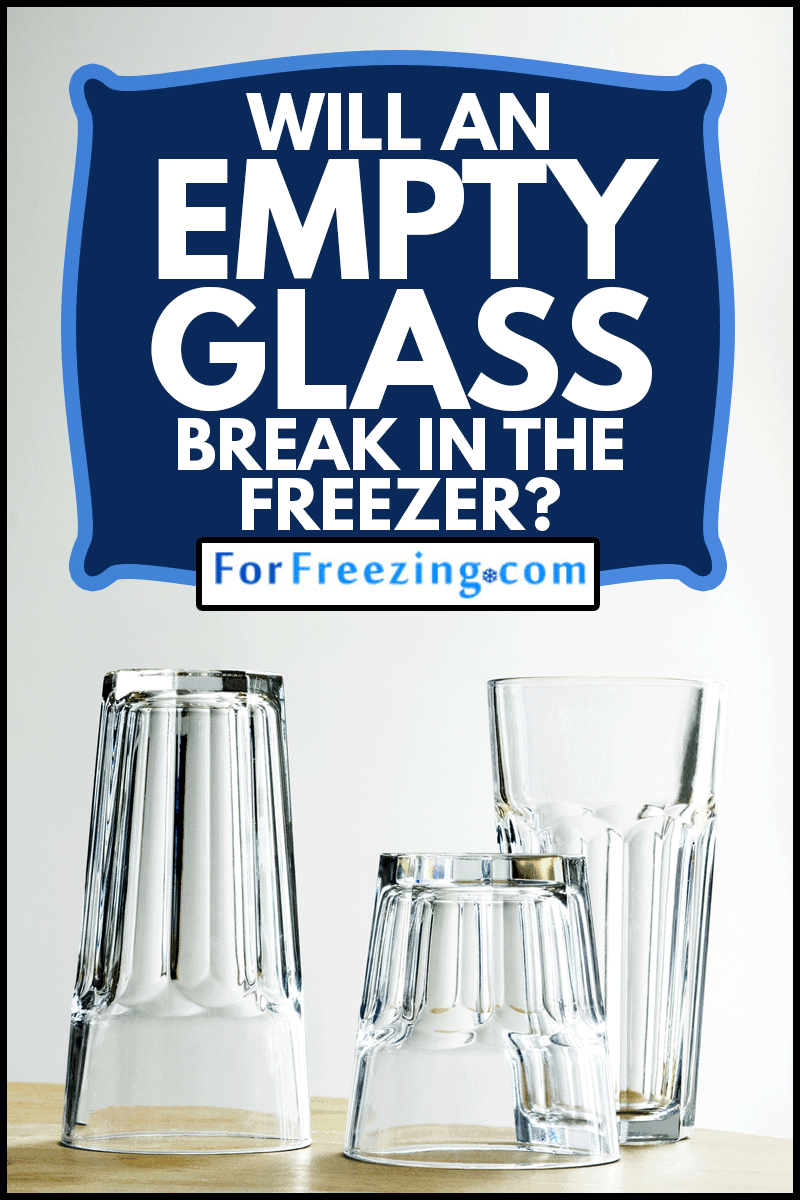Glass is a clean, safe, and eco-friendly material for storing and serving food. However, when you put it in the freezer, you risk breakage. So if you’re wondering if you can freely chill your glass for a cold drink without breaking it or what kind of glass might break in the freezer, then you're in luck. We’ve researched as much as we can to give you the answers.
If a glass is open, empty, and at room temperature or colder when you put it in the freezer, it likely won’t break. Usually, the kinds of glasses available on the market can usually withstand frosting or chilling, except for crystalware.
It’s a simple answer, but you might be wondering about specifics. Keep on reading, and we’ll tell you why glass breaks in the freezer and the kinds that will or won’t break. We’ve also included some additional tips for those of you who like to have your drinks in cold glasses.
NOTE: WE MAY GET A COMMISSION IF YOU DECIDE TO MAKE A PURCHASE THROUGH THESE LINKS. THERE'S ADDITIONAL NO COST TO YOU. CHECK THE BOTTOM OF THE PAGE FOR MORE INFORMATION.

Why does glass break in the freezer?
There’s a lot of physics behind it, but glass breaks because of temperature imbalance.
When you put an object in a freezer, it disperses its heat into the cold air to lower its temperature, and it shrinks as an effect. Glass follows the same principle. However, glass is also an insulator. Therefore, it cannot readily release the heat inside it. As a result, when there is a rapid temperature change, one side shrinks faster as it cools and the glass breaks.
On the other hand, with glassware that is open, like a martini glass, this is less likely to happen. In that case, all surfaces of the glass cool simultaneously, so they shrink together and do not break.
At what temperature does glass freeze and break?
Glass has no actual freezing point. It’s already solid, and therefore, technically cannot be frozen. Ideally, an empty glass should not break in freezing temperatures or temperatures experienced in daily life. But, if you’re freezing a glass for cocktails, for example, 32°F/0°C or a little colder should be enough.
How long can you leave a glass in the freezer?
Based on what we’ve said so far, you can leave an empty glass in the freezer for as long as you need to without breaking it. Just make sure the glasses aren’t subject to rapid temperature changes. However, generally, 30 minutes to about an hour is enough to get a glass frosty.
Glasses in the freezer: To Freeze or Not to Freeze?
Generally, empty glassware made from soda-lime (which is 90% of kitchen glassware) will not break in the freezer regardless if it is freezer-safe or not.
However, when it comes to putting glassware in the freezer for storage, it’s recommended that you avoid using non-tempered glass. Non-tempered glass types retain microscopic air bubbles that are usually eliminated by tempering. Therefore, these glasses are less capable of handling temperature changes or the pressure coming from their contents.
Instead, you should opt for glassware made from tempered glass or labeled freezer-safe. Tempered glass can readily withstand a freezer’s temperature changes because it’s reinforced and thicker. Additionally, if it does crack, the pieces do not have jagged edges.
Can you put crystal glass in the freezer?
Avoid putting crystalware in your freezer because it is too thin and will likely break with the temperature. It is lead glass instead of soda-lime glass or borosilicate, which means it cannot withstand temperatures as those types do.
More importantly, crystalware can be a health hazard because of the lead content. The FDA recommends against using these glasses for storage. They also recommend only using crystalware occasionally for drinking. When used, the drink should not be in the container for more than two hours.
Newer crystal glasses aren’t made from lead anymore but use zinc oxide, potassium oxide, or barium oxide instead.
Are mason jars freezer-safe?
Generally, mason jars or canning jars are freezer-safe. They have thicker glass that can tolerate changing temperatures, and they can handle the pressure of their contents better. However, there is no guarantee that all mason jars won’t crack at all. It is still best to choose those that are labeled freezer-safe.
If you opt to use mason jars, here are some tips to keep them from breaking:
1. Go for wide-mouthed jars with straight edges. Jars with shoulders tend to crack at the level of the curve because of the expanding contents. If you have to use the latter, fill them 1 inch below the shoulder.
2. Follow the freeze-fill line. It’s there to let you know much the jar can hold without breaking in the freezer.
3. Allow the contents and the jar to cool before storing in the freezer. Even if mason jars are more capable of handling temperatures, they can still break if the temperature change is too drastic.
4. Don’t tighten the lid too much when you initially put it in the freezer. You can leave it loose and then close it later.
Tips for Chilling Drinking Glasses

How do you chill glass fast?
If you’re pressed for time or can’t be bothered to do preparations in advance, the following are some tricks you can use to chill glasses in a pinch:
- Place the glass in the freezer for 5 minutes. It won’t be frosted over, but it will be cold enough to serve drinks in.
- Put ice in the glass and allow it to sit while you’re preparing the drink. When it’s ready, take out the ice and water and then strain the drink into the glass.
- If you have a bucket of ice, and at least 15 minutes, place the glass upside down into the ice. When it’s needed, just take it out and wipe it down before pouring the drink in.
- Dampen some paper towels and wring them out. Then, use them to wrap the glasses before putting them in the freezer. The dry air removes the moisture from the paper towels and helps chill the glass faster.
Lastly, if you have access and can afford it, you can use liquid nitrogen. It’s perfectly safe because the nitrogen insulates the glass, so it doesn’t shatter.
How do you frost glass for cocktails?
Frosting for cocktails can mean two things: (1) freezing the glass to get a thin, slightly opaque layer of frost on it or (2) “sugar frosting” where the rim of the glass is covered with sugar or salt.
If you want the cold layer of frost, just put it in the freezer for an hour or longer. Others recommend dipping the glass in water first and shaking off the excess before freezing.
For sugar frosting, first, have the sugar or salt on a separate plate. Next, dip the rim of the glass into some liquid or juice. You can also rub lemon along the edge. Lastly, dip the rim into your sugar or salt.
Should beer be served in a frosted glass?
The consensus says no when it comes to serving beer in a frosted glass unless it’s to cool it from room temperature. Frosting beer mugs can take out a lot of the flavor and add more foam because it’s colder than the ideal 40 to 55˚F temperature. However, there are some beers, like lagers, that taste better when served colder.
final thoughts

So remember, your glass storage container might break in the freezer unless it is tempered glass. However, if you put in an empty glass and there’s no sudden change in temperature, it should be fine regardless of the type, as long as it’s not crystalware.
To frost glasses, you only need to put them in the freezer for 30 minutes. But if you’re in a hurry, 15 minutes will do. You can also use an ice bath or wrap the glasses in paper towels before putting them inside the freezer.



